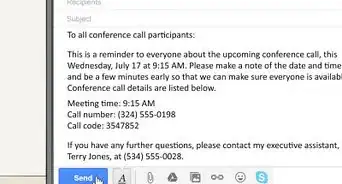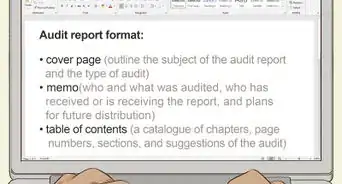wikiHow is a “wiki,” similar to Wikipedia, which means that many of our articles are co-written by multiple authors. To create this article, volunteer authors worked to edit and improve it over time.
There are 8 references cited in this article, which can be found at the bottom of the page.
This article has been viewed 59,307 times.
Learn more...
Vision statements should describe the essential goals an organization sets for itself. Even though the actual vision statement should be simple and direct, writing it requires time and careful consideration.
Steps
Part One: Brainstorm the Vision
-
1Address your core values. Identify the values that exist at the center of your organization. Ask yourself why your organization currently exists and what hopes or ideas led to its founding.[1]
- After identifying your core values, you'll need to evaluate your organization with respect to those values. Determine which aspects of your company are aligned to those values and which aren't, then consider what you should do to better align yourself to those values in the future.
- Your vision statement should match up to your organization's core values. To that end, you'll need to retain any elements that currently fulfill your values while also incorporating new elements that can address those values more effectively.
-
2Focus on problem solving. Companies typically succeed when they can solve a problem or provide something that fulfills various needs and wants. Determine what problems or needs your company addresses.
- If you haven't done so already, identify your customer base and figure out what concerns the average customer within that base. Create an "ideal customer" in your mind, then ask yourself what you want to do for that specific customer.
- After determining what you want to do for your target customer, think about how success will look if you manage to accomplish that goal. The idea of success that you imagine here should morph easily into the overall vision you hold for your organization.[2]
Advertisement -
3Visualize the future. If you have a hard time identifying your vision from your current perspective, try to imagine your organization five to ten years later.[3]
- It may help to draft an imaginary news article describing your organization's ideal future. Write about its biggest accomplishments and compare it to the competition. The accomplishments you hope to achieve should be transformed into elements of your vision.
-
4Dream big and scale down as needed. When you start brainstorming, don't worry too much about how realistic your goals seem. Only evaluate the practicality of your dreams after getting them out into the open.
- For instance, your ultimate goal might involve global success even if your organization is currently a local, small-scale operation. List global success among your dreams during the brainstorming state, then evaluate the practicality of that dream once you sit down to write out your actual statement. Scale back the reach of your goal as needed to make it seem easier for others to grasp.
Part Two: Draft the Statement
-
1Define your output. Your input is what you put into your organization. Your output is the result of those efforts. Use wording that focuses on your output rather than your input.[4]
- For example, a clothing boutique stocks designer clothes and sells those clothes to fashion-minded customers. The "stocking clothes" part is the boutique's input; introducing customers to those clothes is the boutique's output.
-
2Be specific to your business. Avoid writing generic statements that could apply to any company in any field. At the very least, you need to make sure that your vision statement addresses the industry your company exists within.[5]
- Something generic like “customer satisfaction” won't paint a vivid enough picture. In this case, you'll need to describe what customer satisfaction looks like within your field. For something like a clothing boutique, this would mean pairing fashion-minded customers with the best styles or introducing them to the latest trends.
-
3Give it a twist. Even within the same field, your organization has plenty of competition to work with. If there's something positive about your business model that varies from others within the field, reference it within your vision statement.
- For instance, if you own a clothing boutique and a large portion of your stock comes from local artisans, mention that in your vision statement. Doing so could help attract those interested in supporting local business.
-
4Focus on the future. Vision statements describe goals. In other words, you're conveying something you hope to make happen rather than something that is currently happening or currently true of your organization.
- For this reason, most vision statements rely on action-oriented verbs: "to be," "to become," "to make," etc. Instead of saying what your company is, describe what you hope your company will be in the future.
-
5Balance ambition with realism. The statement needs to be ambitious enough to excite people, but it also needs a dose of realism. If it doesn't seem achievable, you might have a hard time finding support.
- This is when you may need to start scaling back the “big dreams” you included in your initial brainstorming sessions. If you own a small business but are on a clear path toward global success, that might be a legitimate goal you can include in your vision statement. Typically, though, you'll need to redefine the scope of your vision to a smaller scale that will be easier for others to accept, like your community, your state, or your country.
-
6Draw in the senses. While it isn't strictly necessary, addressing the "real life" senses of your potential supporters allows you to plant an image in their minds, and that image can make your organization's vision easier to remember.
- The simplest way to do this is typically with a visual. For instance, instead of making "happy customers" your goal, describe your goal as "smiling customers." The latter creates an image, and that image conveys a stronger message.
-
7Limit the length to one sentence. Your vision statement should be short enough to memorize, so aim for one sentence consisting of 10 to 15 words.[6]
- At most, you vision statement should consist of no more than two sentences and/or 30 words. If you feel the need to have a long, detailed vision statement, you should also create an abbreviated version that's easy to recite from memory.
-
8Use clear, simple language. Aside from brevity, a good vision statement also expresses clarity. Avoid complicated wording or inactive phrasing.[7]
- People both inside and outside of your organization should be able to understand the statement, so avoid technical jargon, industry buzzwords, and metaphors.
- Avoid using past tense or the passive voice. You're looking toward the future, so your language needs to do the same.
Part Three: Finalize Your Vision Statement
-
1Adjust as needed. Don't expect to craft the perfect vision statement from the first draft. You should go through at least two drafts of your vision statement, if not more.
- During your first draft, only focus on getting everything down that needs to go down. Think about things like length and language, but avoid fixating on them.
- Review your first draft and revise it as needed, paying closer attention to the finer points you skimmed over previously. Keep the elements that seem most important to you, but rephrase poor wording and remove elements that weigh things down without adding much value.
-
2Seek feedback. Once you feel satisfied with your vision statement, ask someone else to review it. Choose someone who has both wisdom and integrity. This may include mentors, colleagues, or marketing professionals.[8]
- Understand that you may receive both positive and negative feedback. When your statement is criticized, ask yourself if the criticism genuinely seems warranted. Seek a second opinion if you aren't sure.
- Revise your vision statement again if you receive negative criticism that makes sense. When you finish, return it to the original critic and ask him or her to evaluate the effectiveness of your changes.[9]
-
3Spread the vision. Once you complete the final draft of your vision statement, you'll need to spread it around. Communicate your vision to your employees, investors, and potential customers.
- Follow your vision statement as sincerely as possible, too. If you aren't letting your vision statement guide the path your organization takes, you didn't craft an effective or true statement.
- Your company and industry will naturally change over time, of course, and your vision statement may grow outdated. When that happens, reevaluate your vision and start the process anew to create an improved statement that better reflects the current times.
References
- ↑ http://www.businessnewsdaily.com/3882-vision-statement.html
- ↑ https://www.clearpointstrategy.com/how-to-write-a-vision-statement-why-that-isnt-enough/
- ↑ https://www.clearpointstrategy.com/how-to-write-a-vision-statement-why-that-isnt-enough/
- ↑ https://www.cascade.app/blog/write-good-vision-statement /
- ↑ http://wiredtogrow.com/how-to-write-vision-statement/
- ↑ http://topnonprofits.com/examples/vision-statements/
- ↑ https://www.cascade.app/blog/write-good-vision-statement
- ↑ https://bigduck.com/insights/a-better-writing-process-for-strategic-planning/
- ↑ https://bigduck.com/insights/a-better-writing-process-for-strategic-planning/
About This Article
To write a vision statement, start by defining a unique and specific purpose for your organization. For example, instead of saying you manufacture computer parts, state that you're introducing customers to a new way of using technology to make their lives easier. Additionally, try to mention something that sets you apart from your competition, like how your parts are manufactured by local small businesses. Then, write a single sentence that focuses on your goals for the company going forward, such as staying on the cutting edge of your field. For more tips, including how to use imagery to make your vision statement more memorable, read on!









































































